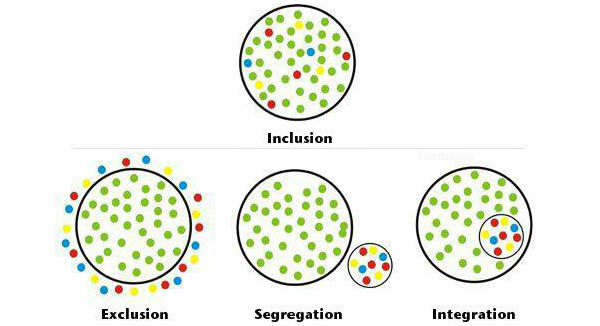
5 Myths And Facts About Inclusion
A few weeks ago, I wrote a short piece explaining what inclusion is and what it isn’t. The insightful comments, which were longer than the original essay, correctly pointed out that the article’s brevity masked the complexity of inclusion. So today I’ll tackle 5 myths and facts about inclusion and how it’s implemented in real life.
Myth #1: Inclusion is easy.
Fact: Inclusion requires effort from all involved parties, and even then it’s not a guaranteed success. Some of the steps that I regularly take to make sure my son is included are:
- Scouting out welcoming venues and making sure the sensory environment is appropriate
- Carrying a sensory toolkit to reduce his anxiety in certain situations
- Identifying the times when he needs extra assistance or patience, and explaining his needs to store employees, librarians, etc.
- Walking my son through his school schedule in an empty school the week before school starts
- Introducing my son to his teachers and helping him create an “All About Me” information sheet
- Rehearsing situations and teaching etiquette proactively
“It is a lot of work with back-up plans for the back-up plans,” wrote Deb on the Friendship Circle blog. Another commenter, Cary, elaborated further:
“Many times I find that a lot of upfront work must go into providing an inclusive situation for the people seeking inclusion. This may involve talking to community leaders about what is appropriate in a given situation, and working with them to make sure that everyone in a situation is comfortable, or that attempts are made for people to be comfortable. This may involve speaking with security guards at a mall in case a full-blown meltdown occurs, making sure that they know what to do... and, more importantly, what not to do should this happen. It may involve talking to waitresses and prepping them for a potential big mess, etc., so that everyone is comfortable with the situation while it is going on.”
Myth #2: Inclusion means that everyone is happy and we all get along great!
Fact: Inclusion is full of surprises, and not all of those surprises are pleasant. Sometimes it may even seem like it creates more problems than it solves - but we can learn from past mistakes and create a better outcome on the next try. I have found that I must be flexible, ready to change plans as my family’s needs change. Over time, these “failures” serve to increase trust between friends and family, which leads to a greater willingness to get up and give it another go. Cary summarized, “True inclusion would be the perfect world.... and we certainly don't live in a perfect world... YET!”
Myth #3: Some people are not candidates for inclusion due to the nature of their disabilities.
Fact: If you are breathing, you are a candidate for inclusion.
If you have been told that inclusion is not an option at this time, consider bringing an advocate to your next IEP or even hiring an attorney. There are creative ways to make inclusion work, such as acclimating a person to a new environment and gradually increasing the length of time spent in that situation. Another way is to identify a person’s interests and building and inclusive environment around those interests and strengths. For example, a person who enjoys art might sign up for a one-day painting class with a family member, and then, if that is successful, sign up for more classes exploring different media at the same studio.
Myth #4: Inclusion only benefits people with disabilities.
Fact: Inclusion helps everyone become a contributing member of a community. When people see another person receiving necessary support to participate, it is reassuring to realize that they will also receive support when needed. Teachers report that the overall classroom climate becomes more respectful and productive when students with disabilities are included. Inclusion introduces life lessons that are not in any textbook, it encourages personal excellence and it fosters interdependence as each person makes valuable contributions. Research has consistently demonstrated a higher achievement level for students without disabilities in a diverse, inclusive classroom.
Myth #5: Inclusion is just another fad - give it time, and it will pass.
Fact: It looks like inclusion is here to stay for several reasons:
- Inclusion is more cost-effective than segregated classrooms and leads to higher achievement for all students.
- About 40 years worth of federal legislation requires that students be placed in the “Least Restrictive Environment” (LRE) and guarantees a “Free and Appropriate Public Education” (FAPE), which in many cases means full or partial inclusion at school.
- At the international level, inclusion is now considered a universal human right.
- Most of human history was inclusive for all members of a community - the concept of segregating people with disabilities was a relatively recent “fad” that thankfully did pass!



